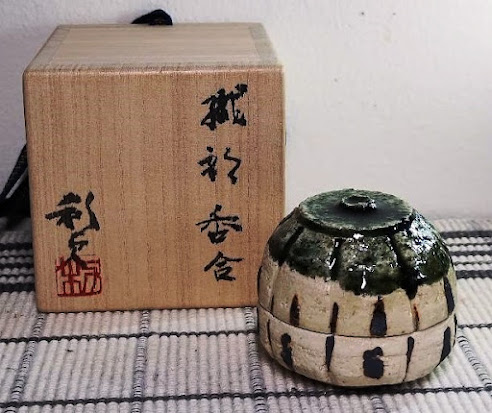250. FUJIMOTO Hide
藤本秀, 1954- , Shigaraki 信楽-ware sculpture, 塊 Katamari (“Mass”)
Fujimoto was born in 1954 in Shigaraki. From 1973, he worked in several potteries and industrial kilns, studying firing techniques and glazes. He established his own kiln, 雲居窯 (Kumoi kama), in the foothills above Shigaraki in 1995. Fujimoto is "inspired by the natural world around him, and the return to nature of the discarded and redundant remains of our civilization." He told Robert Mangold, the owner of the gallery from which I bought this piece, that it was influenced by pier blocks he had seen covered in moss half buried in the earth. For more on Fujimoto, consult his website:
Ceramic artist - Hide Fujimoto Official Site (jimdofree.com).
Light gray Shigaraki clay. Unglazed; all surface colors the result of kiln effects and natural ash glazing. Weight: 5.2 kg (11.3 lb). Height: 16.3 cm (6-1/2 in). Length: 23 cm (9 in). Width: 17.5 cm (6-3/4 in).
This was formed from a solid brick of Shigaraki clay. It has roughly six sides, but each side has many surfaces, formed either of excavated areas or protrusions. The base is flat throughout most of its area but curves up to meet the back side at the rear. There are two spots on the bottom where the unaffected clay shows through. One of these has some incised lines that may be the artist’s sigil. Because of the shape of the bottom, the piece tilts forward. A large cavity was excavated on the top side. The left and right sides also have cavities. The top cavity is rough and irregular. The cavities on the sides are smoother and more regular, perhaps excavated using a chisel or similar tool. The surface texture is rough.
This was unglazed. In addition to the two unaffected areas on the bottom side, the back side also has a spot without kiln effects. There are a few areas colored red, but most of the surface shows colors in the gray to black ranges. The front and back sides have areas of vitrified natural-ash glazing. The bottom side has one of the green glass-like beads known as tambo no me.
This came with a wooden box inscribed by Fujimoto in three lines: 信楽 / 塊 / 藤本秀, Shigaraki / Katamari (“Mass”) / Fujimoto Hide, followed by his seal stamped in red. Included with the piece were an orange wrapping cloth, a short biography in English, and a statement in Japanese about the association between Shigaraki and pottery and Fujimoto’s approach to potting.
Purchased
from the Kura Monzen Gallery in Kyoto, Japan, May 2024 (invoices, customs and
shipping documents)




























